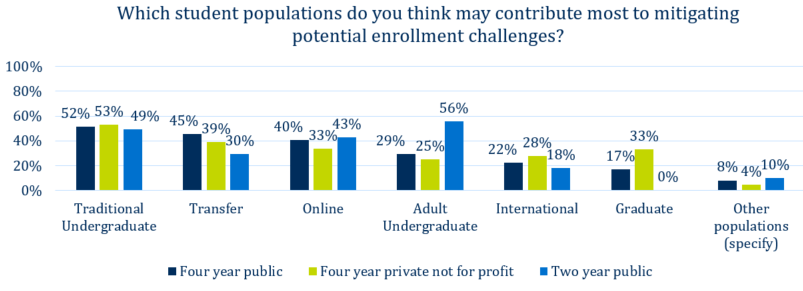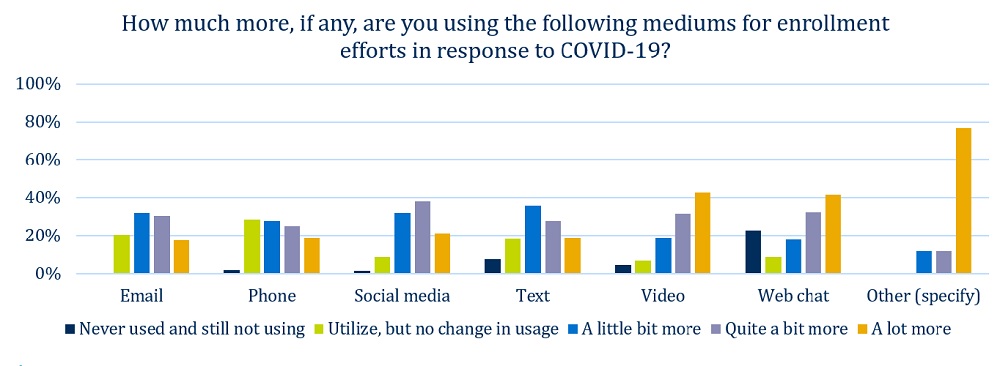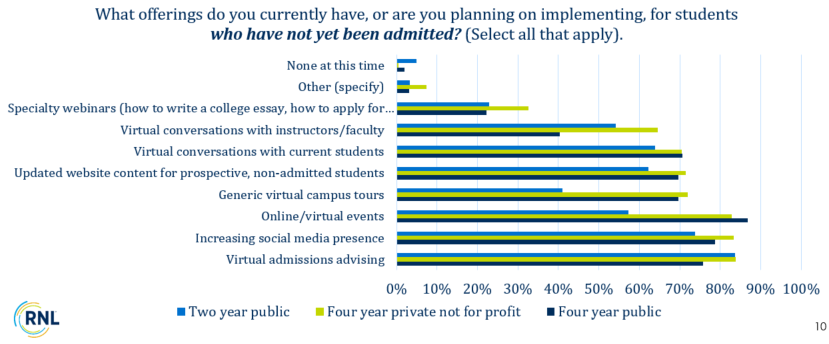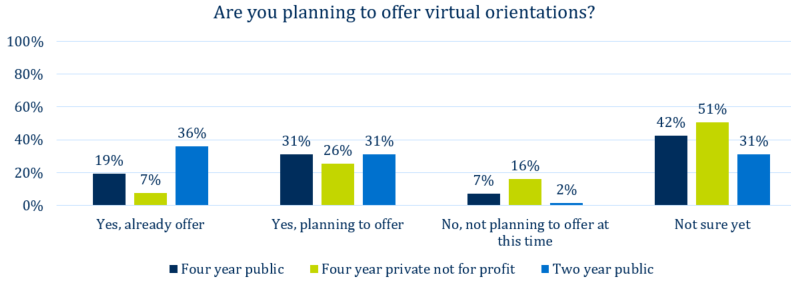enrollment
RNL Research: Almost Half of Institutions Plan Increased Focus on Online Programs
New research findings from RNL indicate that more than 4o percent of institutions plan to focus more attention on online students and about 25 percent plan to focus more attention on either graduate or undergraduate adult students as they seek to mitigate enrollment challenges in 2020 and beyond.
Institutions with strong graduate, online, and adult undergraduate operations may be best positioned to contend with all that the COVID-19 pandemic has in store for our colleges and universities.

We are now a little more than one month into America’s response to the COVID-19 pandemic. Communities, businesses, families, and our colleges and universities have all had to profoundly change nearly everything they do.
A “new normal” is emerging—and changing a bit every day—and it is necessitating the move of the bulk of communications and cultivation strategies to an online/virtual environment.
Virtual campus tours, virtual open houses, online chats with admissions counselors and program faculty and current students, web meetings that simulate any number of face-to-face events, and virtual orientation are only a few of the things that our colleges and universities need to get very good at in a very short amount of time.

Share your insights with us in a quick poll
We are interested in understanding the ongoing transitions happening at colleges and universities, particularly from the perspective of graduate, online, and adult undergraduate leaders and staff. Take our quick poll and help us share your results with the enrollment management community.
Interestingly, institutions that serve large numbers of adult undergraduate students, working professional graduate students, and/or large numbers of online students will be at a significant advantage and may have a lot to share with more traditional institutions.
An investment in developing all of these capacities is strategically wise given that the services and features that busy adult learners need today will soon be in demand by their children as well. RNL was particularly interested in helping colleges and universities learn from one another about what they were doing to make things work during this time.
With this in mind, we administered a survey focused entirely on the most pressing outreach, recruitment, and admissions policies and practices—the things for which thousands of higher education stakeholders turn to RNL each year. Here are some of the key findings from the study.
Institutions are more ready for online learning than you think
Institutions are better prepared from a technological standpoint than they may have thought they would be regarding online programs. One month into the pandemic response, 88 percent of enrollment operations at four-year publics, 86 percent at four-year privates, and 79 percent at two-year publics had been transitioned to an online platform. They have had to make changes faster than ever before and likely faster than they ever thought possible.
Webchat and video are the leading platforms
In just four weeks, more than 70 percent of institutions are using significantly more web chat and video conferencing with their inquiries, applicants, and admitted students, while nearly 60 percent indicate that they have widely increased the use of social media in their communications and cultivation strategy.

Virtual counseling, social media and virtual events are up and running
More than 80 percent of institutions are already using or soon will be ready to do virtual admissions counseling, increase their social media presence, and mount online/virtual events for both inquirers and applicants as well as newly admitted students.

Specialty webinars and other virtual interactions lag
That previous chart also shows that institutions are least prepared to offer “value-added” webinars (e.g.: How to write a college application essay, College 101, Housing Choices, etc.) or to facilitate virtual contact with faculty, other offices, or current students. The value of—and likely participation in—all of these activities has increased dramatically as students and their families are at home for an extended period of time.
Virtual orientation needs to be a priority
About half of four-year publics and about one-third of four-year privates either already have or will soon have an online orientation. Investing in creating such an alternative will prepare institutions for any additional waves of the pandemic or future disruptions.

Each of these activities and initiatives will present a significantly lighter challenge to institutions that have long-served graduate, adult, and/or online populations—populations that have been demanding these types of convenience-oriented services throughout the last decade.
Institutions seeking to attract any of these populations in larger numbers for the first time will be presented with a challenge in that the total universe of higher education is not currently growing (and hasn’t been for a few years now).
They will also be competing with savvy, highly effective institutions that have catered to these populations for many years. The meeting point of these two realities make it more important than ever for institutions to employ the best possible strategies and tactics.
Doubling down on the traditional populations to compensate for anticipated declines in yield will simply make a currently competitive environment even more challenging.
Institutions already effective at delivering via distance will be at a tremendous advantage as we move toward an academic year that will be unlike any other. Institutions ready to serve transfer, online, and adult undergraduate populations, particularly those in more populated regions, will likely see stronger results come fall.
See our full findings in our webinar and participate in our quick poll
Watch our on-demand webinar, How Institutions Are Responding to COVID-19: Findings From Our Survey, for a full review of the research from this study. My colleague Dr. Lew Sanborne and dive into what campus professionals told us about their enrollment adjustments, online learning readiness, major challenges, and more.
I also invite you to take our quick poll about how COVID-19 is changing enrollment for graduate, online, and adult undergraduate students. Share your insights, and we’ll report back in an upcoming blog.

